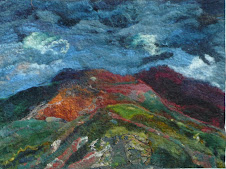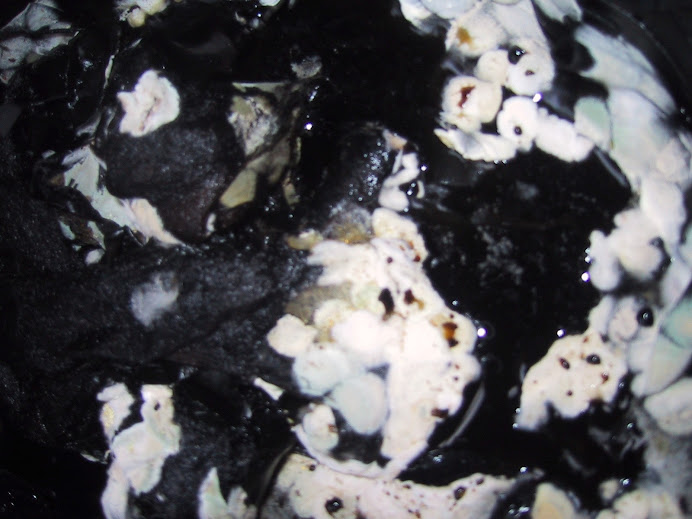Auditorium Isend 2011.
Large Comfortable and well lit.and the hangings were naturally dyed
Harbour La Rochelle
On arrival we were given screen printed bags in natural dyes mine in Genista Tinctoria and alderbuckthorn which for me set the tone for the conference which had a principal focus of commercial production of naturally dyed products and of commercial production of natural dyes.
The first two days seemed a little too full of scientists describing how they found out what dyes were used in ancient textiles whether these were ancient Andean textiles or old European ones, interesting but a bit dry although leavened a bit by people like India Flint. The Round table on Indigo day was principally the two commercial woad producers Woad inc and Blue de Lectoure and others and there was controlled and a very limited discussion about moving natural dyeing into industry which I found frustrating and annoying. In particular I would have liked the problem of indigo dyeing being consistently misrepresented as resulting in crocking and fading to be addressed. Someone else asked for a discussion on vats and given that Michael Garcia was mobbed about his organic indigo vat in the demonstrations it was shame that that was not there nor the description of the indigo dyeing by the Naga tribes which surprisingly came later and which was quite stunning with a description of the extraction of indigo from strobilanthes flaccidfolius from which they achieved a wonderful midnight blue. One group of tribes steamed their indigo after extraction and the shade went from mid blues to dark blues.
Finally the last two days were for me the most interesting ones with A talk on sustainable dyeing processes with dyestuffs based on renewable resources , slow dying, colour therapy for learning disabled artists-a very moving and appealing account from Karen Urbanek-. We heard about the revival of cochineal dyeing in Lanzarote as I had some of this cochineal to test and which was excellent I enjoyed this . I warmed too to the speaker who described using discarded flowers from Culcutta market to dye with.
There were a lot of speakers and they all had only ten minutes to speak. The time keeping was rigidly controlled so that the conference ran like clockwork-it was very organised but oh! how we some time longed to see more. There was small wails of despair as Ms Angelina from Pisa University on being told she only had a few minutes shot through a series of fascinating research projects in Italy
MIchael Garcia with blue from his organic vat using crushed oyster shells and fructose.
Below Block printing
Purple from the root of lithospermum erythrorhizon
The demonstrations, labelled workshops, were a bit chaotic as by the time you got out from the afternoon talks and had a loo break the demo's were thronged and the popular ones were impossible to see. A booking system or a staggered timing would have helped here. Michel Garcia's organic vat was the one that I most wanted to see but it was sadly all in French and he was thronged with eager dyers although was kind enough to give us an English talk later on. His vat -organic because it came from organic natural ingredients and not artificial ones was fascinating. Michael Garcia used lime from crushed oyster shells and fructose or hennas to reduce the vat . Fantastic! And as soon as I have the ingredients I will start experimenting with it.
Another lovely vat was that of Mr Gasali Ademayo a Nigerian living in Mexico demonstrating Adire using indigo from balls of the native indigo plant of Nigeria. His balls looked like just woad balls but contained wood ash as well. Ian Howard of Woad Inc explained to me that there was view that adding wood ash to fermented balls increased the production of indigotin from the plant material.
A variety of outing were offered on Wednesday with a picnic and I went to a madder farm where we had a fascinating visit to the only commercial madder grower in France but even he only had a small percentage of his farm down to dye plants, -madder, & coreopsis .The farmer explained that madder was difficult to germinate that he was experimenting with regenerating a harvested field as madder even when harvested as he does with a converted potato digger comes back. The newly seed area had huge gaps between the plant. These are problems anyone growing madder knows and I felt sad that he seemed to have to reinvent the wheel.
Newly madder field, not only was germination difficult but the young seedling were attacked by worms/
The trade stalls came form all over with the UK represented by amongst others The Mulberry Dyer ( officially France but I reckon we can claim her)! And who probably has the busiest stall on the market and Judy Hardman with beautiful hand knitted fair isle sweaters and her books too. There were a lot of stalls selling made times and a variety of scarves and stoles abounded. My DH treated me to wonderful patterned and stitched scarf form the Weavers Studio from India quite yummy but predictably I bought dyes including some fabulous indigo from Bangladesh , hopefully some from El Salvador and some Cochineal from Lanzarote.
Judy Hardmans stall + her DH
Judy Hardmans stall + her DH
The Weavers Studio . The scarf on the left was the type like my 60th birthday present form DH ONLY MINE IS NICER! Centre piece is sampler of shibori used.
I loved it -had a fabulous time and met lots of lovely people and really enjoyed the really outstanding leisurely lunches although if they had catered for my food allergy diet there was no sign of it, . I adopted the policy of sitting wherever there was a seat at lunch and met some fascinating people who I really enjoyed chatting too and it was meeting the other artisan dyers from all over the worls and renewing friendships that was one of the most important parts of the conference.
 Show all posts
Show all posts

































